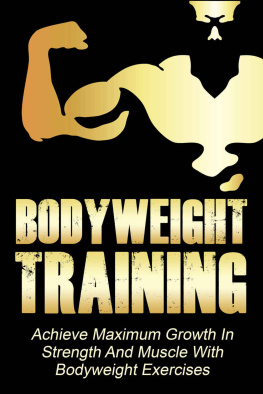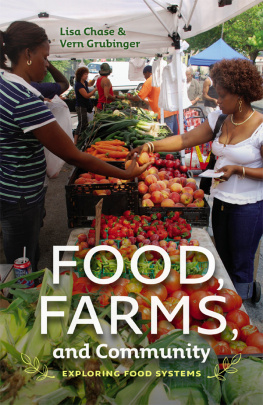Contents
Guide
Pagebreaks of the print version
Praise for
The Community Food Forest Handbook
The increased interest in botanical sanctuaries, forest gardens, and nurtured edible gathering places is a sign that many are seeking to rekindle our relationship with these spaces as caretakers in these modern times. Learning how to nurture food forests builds community resilience, engagement, health, and stewardship. The Community Food Forest Handbook is perfect for townships, urban planners, landscape designers, community organizers, land trusts, permaculture enthusiasts, and foragers who aspire to dig in and seed our future. Catherine Bukowski and John Munsell have created a timely, well-researched guide that provides plenty of hands-on tools for advocacy and implementation based on diverse case studies from across the country. In the spirit of Robert Harts classic Forest Gardening , it gives hope to see the community food forest trend rapidly resurging.
Susan Leopold, executive director of United Plant Savers
The Community Food Forest Handbook opens the door to a new, rapidly expanding approach to agroforestry in urban areas and communities. Rather than focus on the technical aspects of planting and production, Catherine Bukowski and John Munsell address sociological challenges inherent in planning and sustaining community food forests, as well as potential solutions. The result is a comprehensive resource for adapting practices traditionally applied to privately owned rural land for the enrichment of community-managed greenspaces.
Susan Stein, director of National Agroforestry Center of USDA Forest Service
Wedding community renewal with agroecology, Bukowski and Munsell offer us a remarkably rich harvest of wisdom from a quarter of a century of insight and struggle in the community food forest movement. First fruits are everywhere consumed to nourish the spirit, reward unlikely heroes, and propitiate success. Partake of The Community Food Forest Handbook , and celebrate permaculture taking hold of Americas imagination: from Seattle to Asheville, Syracuse to San Francisco, and in dozens of cities across the fruited plain, perennial culture is rising.
Peter Bane, president of Permaculture Institute of North America
As communities seek both to grow food and to solve social and environmental problems, they need new insights into the ways in which people self-organize to initiate projects and sustain them in the long term. In The Community Food Forest Handbook, the authors offer a highly useful guide based on the collective wisdom of people and communities who are defining this practice as they develop it on the ground. The thoughtful analysis of planning strategies and numerous case studies of active projects help us all understand what community food forests are and can be for the future.
Steve Gabriel, author of Silvopasture and coauthor of Farming the Woods
Its great to see a book about food forests / forest gardens which concentrates on community-scale projects. These need design and management not only for the growing system itself, but also for the human community that nurtures the forest and is often much neglected. The Community Food Forest Handbook does an excellent job of tackling the social issues and includes some highly informative case studies of community projects.
Martin Crawford, director of Agroforestry Research Trust; author of Trees for Gardens , Orchards, and Permaculture
The Community
Food Forest
HANDBOOK
How to Plan, O rganize, and Nur ture Edible Gathering Places
Catherine BukowskiJohn Munsell
Foreword byLaManda Joy
Chelsea Green Publishing
White River Junction, Vermont | London, UK
Copyright 2018 by Catherine Bukowski and John Munsell
All rights reserved.
Unless otherwise noted, all photographs
copyright 2018 by Catherine Bukowski
Photographs on
courtesy of Jonathan H. Lee, www.subtledream.com.
No part of this book may be transmitted or reproduced in any form by any means without permission in writing from the publisher.
Project Manager: Alexander Bullett
Acquisitions Editor: Makenna Goodman
Developmental Editor: Fern Marshall Bradley
Copy Editor: Nancy Bailey
Proofreader: Rachel Shields Ebersole
Indexer: Shana Milkie
Designer: Melissa Jacobson
Page Composition: Abrah Griggs
Printed in Canada.
First printing July, 2018.
10 9 8 7 6 5 4 3 2 118 19 20 21 22
Our Commitment to Green Publishing
Chelsea Green sees publishing as a tool for cultural change and ecological stewardship. We strive to align our book manufacturing practices with our editorial mission and to reduce the impact of our business enterprise in the environment. We print our books and catalogs on chlorine-free recycled paper, using vegetable-based inks whenever possible. This book may cost slightly more because it was printed on paper that contains recycled fiber, and we hope youll agree that its worth it. Chelsea Green is a member of the Green Press Initiative (www.greenpressinitiative.org), a nonprofit coalition of publishers, manufacturers, and authors working to protect the worlds endangered forests and conserve natural resources. The Community Food Forest Handbook was printed on paper supplied by Marquis that contains 100% postconsumer recycled fiber.
Library of Congress Cataloging-in-Publication Data
Names: Bukowski, Catherine, author. | Munsell, John, author.
Title: The community food forest handbook : how to plan, organize, and nurture edible gathering places / Catherine Bukowski and John Munsell.
Description: White River Junction, Vermont : Chelsea Green Publishing, [2018] | Includes bibliographical references and index.
Identifiers: LCCN 2018007439| ISBN 9781603586443 (pbk.) | ISBN 9781603586450 (ebook)
Subjects: LCSH: Edible forest gardens. | Community gardens.
Classification: LCC SB454.3.E35 B85 2018 | DDC 635dc23
LC record available at https://lccn.loc.gov/2018007439
Chelsea Green Publishing
85 North Main Street, Suite 120
White River Junction, VT 05001
(802) 295-6300
www.chelseagreen.com
To my parents, Sandra and Fran,
and my grandpa, Henry, for teaching me to love gardening
and understand the value of sharing good food.
To my husband, Jon, for accompanying me on the journey
and to all my family for their endless support.
CJB
To E, O, and C. No way, no how, without you.
JFM
Contents
The end of the Second World War marked the conclusion of an era in the United States when individuals and entire cities had a much more intimate and informed relationship with their food and where it came from. Pre-war food production was smaller, more decentralized, and closer to home. Many families, urban and otherwise, raised a few chickens and tended a home garden. A large percentage of the produce consumed in urban areas was grown within or close to city limits. In my adopted hometown of Chicago, there were neighborhoods known as Celeryville or Pickletown where businesses grew and processed food crops for the expanding urban, overwhelmingly immigrant, population. These farms provided food, yes, but also jobs, community, and a sense of belonging in a new land.
The juggernaut of the Second World War created efficiencies and businesses that had never existed pre-war, and, after the conflict ended, many industries retrofitted themselves to the challenge of a new American dream that didnt involve the day-to-day drudgery of food production. As the task of putting food on the table shifted from growing it yourself or buying it from a local farmer to weekly shopping trips to newly ubiquitous grocery stores, those precious home and locally based food production skills and networks began to fade away.
















